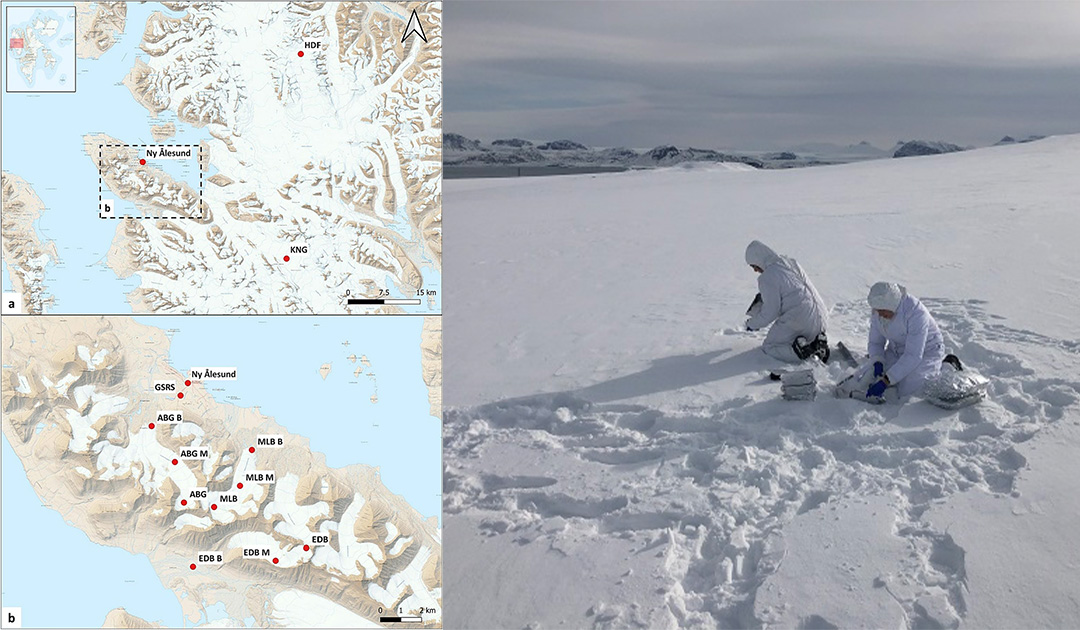
For the first time, researchers detected chemicals from personal care products in the snow near Ny Ålesund on Spitsbergen, including various chemical UV filters from sunscreen.
Since the industrial revolution, chemicals have been released into the environment, causing damage to ecosystems and often also to humans. Today, more than 350,000 chemicals and chemical mixtures are registered globally, and new ones are constantly being developed. Many of them have accumulated in the environment worldwide, sometimes with severe effects on organisms. Some have already been banned, such as polychlorinated biphenyls (PCBs), and studies show that their concentrations in the environment are falling again. This is good news, but it should not obscure the fact that newer chemical compounds are being released in large quantities into the atmosphere and into lakes, rivers and oceans, with consequences for ecosystems that have barely been investigated.
As everything on Earth is interconnected, these chemicals also find their way into the Arctic. In particular, the long list of “Chemicals of Emerging Arctic Concern” (CEACs), including flame retardants, plasticisers, pesticides and many more, is causing concern among experts and was already examined by the Arctic Monitoring and Assessment Programme (AMAP) of the Arctic Council in 2016. In the Arctic, CEACs have been detected in surface waters, seawater, terrestrial and marine organisms, snow and wastewater.
In spring 2021, an Italian-Norwegian research team set out to search for very specific compounds in the snow of Svalbard: Chemicals from personal care products – the first study on this in the Arctic. To gain an overview of their occurrence in the Arctic, the researchers collected snow samples on three glaciers on the Brøggerhalvøya peninsula, at the Gruvebadet Snow Research Site near Ny Ålesund and on the Kongsvegen and Holtedahlfonna glaciers, which are around 40 kilometres from the research settlement.

In the upcoming issue of Science of the Total Environment, they report that several commonly used compounds such as fragrances and chemical UV filters are present in Arctic snow. “Many of the contaminants we have analysed, such as Benzophenone-3, Octocrylene, Ethylhexyl Methoxycinnamate and Ethylhexyl Salicylate had never been identified in Arctic snow before,” says Marianna D’Amico, a PhD student in Polar Sciences at Ca’ Foscari University in Venice and lead author of the study, in a university press release. The four compounds mentioned are used as UV filters in sunscreens.
On all of the glaciers studied, with one exception, the researchers detected higher concentrations of UV filters in the snow that fell in winter than in the underlying snow from previous seasons. Two of the UV filters, benzophenone-3 (BP-3) and octocrylene, occurred more frequently in the summit areas than at lower altitudes.
“The results show that the presence of emerging contaminants in remote areas can be attributed to the role of long-range atmospheric transport,” Marco Vecchiato, researcher in analytical chemistry at Ca’ Foscari University and co-author of the study, explains in the press release. “In fact, the highest concentrations were found in winter deposition. At the end of winter, contaminated air masses from Eurasia reach the Arctic more easily.”
“The most noticeable example concerns certain UV filters normally used as ingredients in sun creams. The highest winter concentrations of these contaminants can only be traced back to the continental regions inhabited at lower latitudes: in Svalbard, during the Arctic night, the sun does not rise and sunscreens are not used,” Vecchiato adds.

However, the snow only acts as a temporary reservoir for these chemicals. As soon as it has melted, they can threaten ecosystems and organisms. The effects they have on animals and plants in the Arctic have yet to be researched. However, it is known from other regions that UV filters accumulate in marine organisms, trigger toxic effects on the skin on contact with sunlight and harm the endocrine system. They also have a damaging effect on coral reefs, which is why Hawaii, the US Virgin Islands and Palau have banned three of the compounds.
Chemicals from personal care products are released into the environment via household and industrial wastewater, for example, or are released directly into the air through the use of perfume or sunscreen sprays. They reach remote regions such as the Arctic via ocean currents and the atmosphere. Local or regional sources can also play a role.
Julia Hager, PolarJournal
More about this topic:





